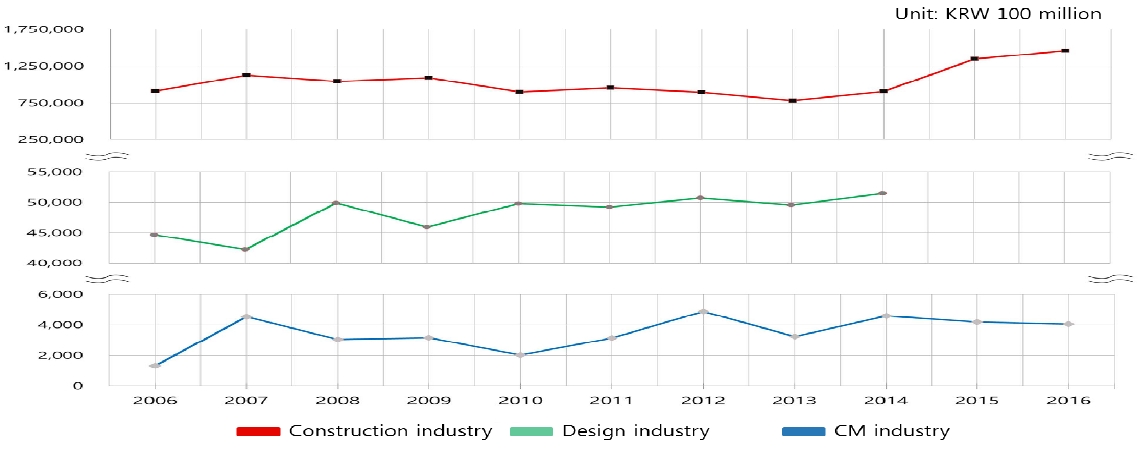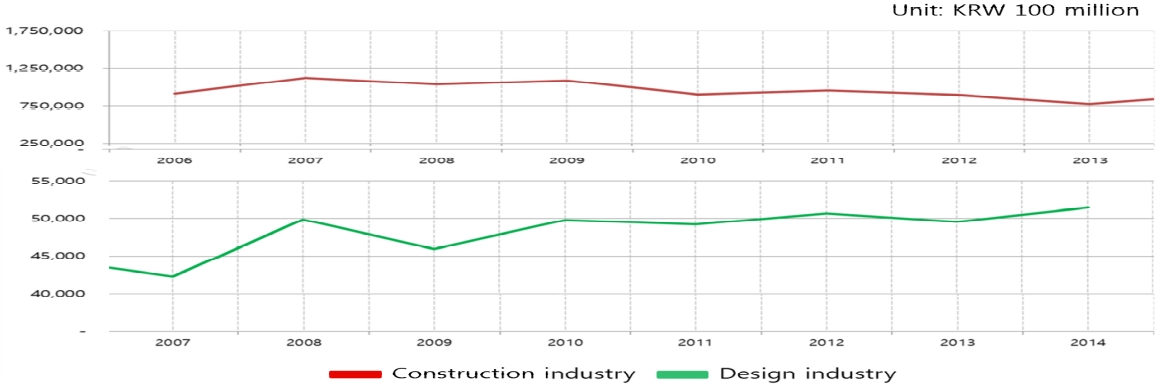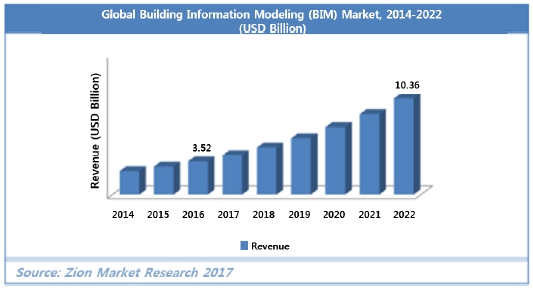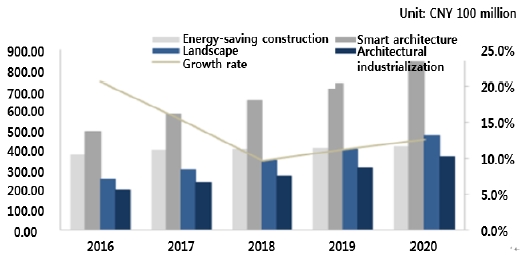
Analysis of the Interrelationship and Stagnant Strategy according to the Transition Process and Sales Analysis of the Domestic Construction, Design, and CM Industries
ⓒ 2020. KIEAE all rights reserved.
Abstract
Korea’s construction industry has grown together with the design industry and the CM industry, but it is showing continuous growth, stagnation, and regrowth due to changes in domestic and international economic conditions. The purpose of this study is to identify the size of the design industry and the CM industry and the cycle of growth and stagnation compared to the construction industry and to suggest the prospect of sales in each sector and the necessity of specialized technology.
As a method of research, first, the change process and trend of each industry according to the periods of domestic construction industry are identified. Second, it analyzes policy change of each industry and analyzes the process of growth and stagnation along with the change process. Third, the sales analysis by sector suggests the size and outlook of the design industry and the CM industry compared to the construction industry and the necessity of specializing in specialized technologies.
As a result, the proportion of the design industry's sales to the construction industry is expected to be about 5% and that of the CM industry to the design industry is about 7%. The domestic construction industry repeats growth and stagnation every about 10 years, and the next stagnation period needs to be considered. Accordingly, it is necessary to prepare for the future by specializing technologies related to eco-friendly construction, Smart construction technology, plant, and new city construction, which will further increase in value in the future.
Keywords:
Construction industry, Architectural design industry, Construction management industry, Construction revenue, Changes in the construction industry1. Introduction
1.1. Background and Objective
Domestic construction industry has been developing since the Japanese colonial era and the Korean War with the aim of rebuilding national infrastructure and economy. Since the 1960s, the construction industry has contributed to the national economic development through economic development plans and infrastructure facilities. The domestic construction industry was established in the 1970s with industrialization and expansion of investment capital through large-scale economic and land development projects. The construction industry has continued growing into a key national industry. However, in 1998, the construction industry entered a depression period after facing financial crisis from various domestic and foreign economic situation and policy changes. Furthermore, it continued experiencing cycles of growth and stagnation until recently after overcoming the financial crisis. It faced another breakthrough, by recording highest order amount of approximately 134 trillion KRW in 2015 and approximately 146 trillion KRW in 2016. With the repeated cycles of growth and stagnation of construction industry, the design and construction management (CM) industries have equally changed, and the collaboration of these industries are becoming increasingly important[1].
The domestic construction industry undergoes depression period in approximately 10-year cycles. It has repeatedly carried out activation and stabilization policies with respect to sales according to domestic and international circumstances as well as the construction market status. In particular, it has grown by utilizing the government policies of the times and overcoming the depression periods with the assistance of the government’s market activation policy. Currently, when there is a possibility for a downward trend after the third growth period of the industry, the industry should prepare itself for a recession in the future while revitalizing international markets by utilizing the government's long-term and active policies, eco-friendly technology, and smart construction technology.
Herein we examine the change process and policy changes of the construction, design and CM industries, and the overall transition process and trends of each industry from the past to date. In addition, we examine the size and prospect of design and CM industries compared to the construction industry through sales analysis, and present the importance for specialization of eco-friendly and smart construction technologies to prepare for the next depression period.
1.2. Research Method and Scope
The research method of this study is as follows:
First, the change process and trends of construction, design, and CM industries are examined, according to the period division of the domestic construction industry.
Second, the growth and stagnation processes of the domestic construction, design, and CM industries are analyzed, along with the change process by identifying the policy changes.
Third, the sizes and prospects of the design and CM industries relative to the construction industry are presented through sales analysis by sector.
Fourth, the importance for specializing eco-friendly, smart technology in preparation for the next depression period is presented.
The scope of this study is as follows.
The period for change process and policy changes of the domestic construction, design, and CM industries is limited to the late 1970s to the present. The data used for sales analysis is from 2006 to 2016 for construction and CM industries, and from 2006 to 2014 for the design industry. Furthermore, for sales comparison by sector, the data used is from 2006 to 2014.
2. Change Process of Domestic Construction, Design, and CM Industries
2.1 Period Division of Domestic Construction Industry
Since the 1970s, the domestic construction industry has grown rapidly, and has been undergoing changes through depression and regrowth. The industry can be divided based on construction order amount into the following construction periods: primary growth, primary depression, secondary growth, secondary depression, and tertiary growth periods[2].
In the late 1970s, the construction industry began to grow rapidly as it entered the Middle East construction market, which was the beginning of construction period. The domestic construction industry reached its peak in the late 1980s, and experienced the primary growth period. However, in 1998, the industry faced primary depression period owing to financial crisis. In the 2000s, the industry recovered orders owing to the global low interest rates, and enjoyed the secondary growth period. In 2008, the industry entered secondary depression period owing to the changed economic conditions resulting from a global financial crisis. Since 2014, the construction industry is expecting a tertiary growth period owing to an increase in international orders[3].
2.2. Changes in domestic construction, design, and CM industries
During the construction period, the construction industry played a key role in the national economic growth owing to the international construction boom with entry into the Middle East market as a launching pad. In this period, the construction industry emerged as a major industry and rapidly grew owing to the economic development plan, industrial facilities and SOC investment surge. The annual average growth rate in construction orders recorded 15.6%. The main form of business in the design industry was design trend offices of artists, who learned detailed design techniques through subcontracts from foreign construction companies; the turnkey method was introduced in the design industry. At the moment, the concept of CM was spread in South Korea from foreign construction markets. In the primary growth period, the domestic construction orders reached a peak with construction of two million apartment houses, expansion of SOC facilities, 1986 Asian Games, and 1988 Olympics. Therefore, the industry met with a golden age with an annual average order growth rate of 25.2%. In the design industry, large corporate offices were formed with the introduction of CAD (computer-aided design) and computerization. In the CM industry, after large accidents, such as the Seongsu Bridge collapse in 1994, the Daegu subway explosion and Sampoong department store collapse in 1995, the poor management of the construction industry became an issue. Consequently, CM was serviced to domestic large national projects, which provided an opportunity for the institutionalization of CM. In the primary depression period, which was caused by a financial crisis, many Korean construction companies faced financial difficulties and bankruptcies owing to involuntary and compulsory structural reforms, bankruptcy of financial institutions, and shortage of funds. The design industry changed from a labor-intensive market into active use of computer programs, and adopted division of labor through a partner system of design and engineering. In the CM industry, the contract method for large CM projects was established through the National Contract Act in 1999. During the secondary growth period in the 2000s when housing construction and real estate development were active, project financing (PF) projects led by construction companies increased. With the growth of the turnkey market, the design market became dependent on the turnkey market, and the technical proposal bidding system was introduced; design and supervision began to be separated in earnest. The CM industry maintained stable growth through the enhancement and commercialization of CM/PM capabilities, and entry into international markets[4, 5].
In the secondary depression period, owing to the global financial crisis, the housing market in the construction industry significantly shrunk and unsold houses increased substantially. The design industry faced turnkey market decline; the design market contracted, and large offices and famous artist studios was polarized. The CM industry actively advanced to the international markets; however, sales declined as the domestic construction market shrunk. Meanwhile, the construction responsibility, a type of construction project management system, was introduced. Since 2014, when the tertiary growth period began, the construction industry has continued to expand and specialize the soft domain, such as design, engineering, and CM. Moreover, the design and CM industries are expecting to improve service quality and create profits using building information modeling (BIM) and big data, and through advancement to the international markets [6]. BIM is currently being utilized by approximately 50% of large construction companies, and other companies are also preparing to introduce BIM. Large design offices and CM companies are deploying BIM experts, and are expecting to create profits from a long-term perspective by actively utilizing big data through BIM and data computerization in future foreign projects.
In addition, various cases of cost reduction and quality improvement through BIM, big data, and value engineering (VE), as well as improvement of construction efficiency and prevention of reconstruction through BIM modeling are being published in various fields. Although securing immediate profits is challenging because there are few actual application projects unlike the market activation policy of the government, the specialization of smart construction technology is indispensable to actively enter the international markets where BIM is actively being applied. The BIM applications are expected to gradually increase in South Korea just like in the international markets.
2.3. Policy changes of domestic construction, design, and CM industries
Since the 1970s, real estate prices surged owing to the inflow of oil money from the Middle East, various SOC construction projects through the hosting of the 1986 Asian Games and the 1988 Olympics, and the three-low boom, i.e. low interest rates, low oil prices, and low dollar. Thus, the main policies during this period were anti-speculation policy and stabilization policy. The CM sector became common in South Korea during this period. Regarding the policies in the primary growth period, which was the peak of the domestic construction industry, a policy to stabilize housing prices and a real-name financial system were introduced in line with the promotion of various SOC constructions and the continuous boom in the construction industry. During this period, there was poor management of the construction industry. Therefore, CM system was introduced in the Framework Act on the Construction Industry in 1996, and a basis for consignment of CM work was established by the Framework Act on the Construction Industry in September 1997. During the primary depression period, the housing demand and prices decreased significantly owing to the weak household economy that resulted from income reduction and high interest rates. To overcome the economic depression, low interest policy and housing economy revitalization measures were implemented [5]. Meanwhile, the Ministry of Construction and Transportation, and industry organizations and associations discussed CM policies, and the large CM project contract method was established through the National Contract Act in 1999. In the 2000s, during the secondary growth period, the low interest policy was maintained and the real estate demand increased with the 2002 World Cup. The real estate prices significantly increased owing to the real estate deregulation policy to recover the construction economy, and accordingly, demand and supply management policies were promoted through regulations. Since the 2000s, the CM industry developed further with the introduction of advanced CM techniques, preparation of detailed standards for CM service contract, introduction of CM capability evaluation and disclosure system, revision of detailed evaluation standards for construction industry managers’ project performance abilities, and revision of CM pricing standard. In the secondary depression period, investment and infrastructure construction were activated, construction accidents were reduced using big data, and the construction responsibility type construction project management system was introduced. Meanwhile, the concept of construction responsibility type construction project management was introduced through the Framework Act on the Construction Industry. Since 2014, infrastructure and investment revitalization measures, construction safety accident reduction measures using big data, and construction responsibility type construction project management systems have continued. Furthermore, the government is making efforts to develop: technology system improvement plan, 3D programs, design support development and standardization work, and new technologies. Green building revitalization measures are also being implemented.
3. Sales Analysis by Sector
Since 2006, the construction industry recorded the lowest total sales, approximately 78 trillion KRW, in 2013 during the secondary depression period. The sales began to increase in 2014 when the secondary growth period started, and reached a record high of 146 trillion KRW in 2016. The sales of the design industry continued to increase and decrease; the lowest sales of approximately 4.2 trillion KRW was in 2007 during recovery period and the highest sales of approximately 5.1 trillion KRW was in 2014 during the secondary growth period. The design industry is significantly affected by the economy of the construction industry. The sales of the design industry increase with increase in the sales of the construction industry. Generally, the design industry recovers about a year after the recovery of the construction industry from a depression period. Simply, the sales of the design industry show a similar pattern of the sales changes after approximately one year of the construction industry. From 2006 to 2016, the sales of the design industry are approximately 5.11% of that of the construction industry on average. The sales of the CM industry showed a similar pattern to the construction industry until 2014. The sales grew to approximately 454.3 billion KRW in 2007 and thereafter decreased continuously. The CM industry recorded the highest annual sales of approximately 488.6 billion KRW in 2012; however, since 2015, the sales have continuously been approximately slightly above 400 billion KW.
From 2006 to 2016, the proportion of the CM industry’s sales to the construction industry was approximately 0.34% on average.
From 2006 to 2014, the proportion of the CM industry’s sales to the design industry was approximately 6.9%.
4. Need for Specialization of Smart and Eco-friendly Construction Technologies in Preparation for Depression Period in Construction Industry
Currently, the construction industry is changing from upward to downward trend. To significantly shorten the depression period of the construction industry, active advancement to the international markets is essential, and the industry should actively utilize national policies in the long term. The smart construction technology promotion and eco-friendly construction policies are being actively enforced by the government currently for the construction industry. These two technologies will become important specialized skills in preparation for the future construction industry, and the government will continuously develop various promotion policies.
The industry should actively utilize the eco-friendly construction-related policies and smart construction technology promotion policy developed by the government over the long term. Many large companies are using or planning to introduce smart construction technologies, such as BIM and big data. In 2018, the South Korean government implemented a smart construction technology promotion policy. However, the actual result was poor owing to ambiguous purpose, method, and effect of the technologies, and inadequate concrete support policies considering the business type and size. Consequently, the Ministry of Land, Infrastructure and Transport launched the ‘smart construction technology development project’ with an investment of approximately 200 billion KRW until 2025 for construction sites. In addition, the ministry is planning to develop smart maintenance technology for road and underground facilities of 200 billion KRW for implementation of a smart process from design to construction, and maintenance. Hence, the smart construction technology promotion policy will continue.
The growth of the BIM market is because of the increasing number of governments adopting BIM and the active introduction of smart construction technology. They are expecting to improve efficiency and reduce indirect costs using BIM.
A market analysis report published by MRPL (Market Research Future) predicted that the international market will grow at an annual growth rate of 14.9% from 2018 to 2023, and the market size will grow from $3065.5 million in 2017 to $10.36 billion in 2023.
For large projects in Scandinavian countries, the UK, France, Canada, and other countries, 2D drawings are determined by contract, and 3D tasks, such as BIM, are mainly performed. 2D drawings are collected only if the client requests them.
South Korean companies have also carried out CM projects in Myanmar, Vietnam, Cambodia, and Indonesia with government funding support, and are expecting to enter more international markets if they actively use smart construction technology, such as BIM.
The South Korean government is also maintaining active promotion policy for eco-friendly construction technologies. The related laws encourage construction of green buildings through green building certification system and incentives to stimulate eco-friendly construction. Consequently, the number of green buildings has increased rapidly, and the number of certifications is increasing rapidly through the active support by Seoul City.
China, one of the largest foreign markets, is also actively promoting eco-friendly construction policies. The China Industrial Information Network predicted that the Chinese market size for green buildings in 2020 will be approximately 83,922 million yuan, 41.961 million yuan for energy-saving constructions, 47,206 million yuan for landscapes, and 36,716 million yuan for industrial construction.
The eco-friendly construction reforms of Chinese government are expected to continue in the future. This indicates that the trend and demand for eco-friendly construction will continue both domestically and globally.
Currently, the construction industry is changing from upward to downward trend, and entry to the international market is essential to significantly shorten the depression period of the construction industry. Furthermore, it is necessary to actively utilize the national promotion policies over the long term.
The domestic construction industry experienced repeated cycles of activation and stabilization policies regarding sales, which is related to domestic and international circumstances and the construction market status. The domestic construction industry has grown by utilizing government policies, and overcome the depression period through the market activation policy of the government. At the moment, when the tertiary growth period can shift to a downward trend, the construction industry should prepare for the depression period while actively advancing to international markets using eco-friendly and smart construction technologies, which are the long-term active polices of the government.
5. Conclusion
Currently, the domestic construction, design and CM industries have gone through the following construction periods: primary growth, primary depression, secondary growth, secondary depression, and tertiary growth periods. Since 2014, the construction industry has continuously made efforts to increase its value by developing the soft domain, including design, engineering, and CM. The design and CM industries are actively advancing to international markets while preparing for the utilization and application of BIM and big data. Collaboration among the industries through computerization will become more important, and efforts toward the development and standardization of building design support systems will continue. When the sales of the construction, design and CM industries are compared, the sales of the design industry show a similar trend to that of the construction industry after approximately one year. From 2006 to 2016, the proportion of the design industry to the construction industry was approximately 5.11% on average, and is expected to continue being approximately 5%. The sales of the CM industry show a similar pattern to that of the construction industry until 2014. From 2006 to 2016, the sales of the CM industry were approximately 0.34% of the sales of the construction industry on average. From 2006 to 2014, the proportion of the CM industry to the design industry was approximately 6.9%, and is expected to be maintained at approximately 7%. The domestic construction industry undergoes repeated cycles of growth and stagnation every 10 years. Currently, the industry is thriving through international orders; however, the next depression period should be considered in the changing process according to various domestic and foreign circumstances. The domestic and international interests and demands are increasing with close collaboration among construction, design, and CM industries. The industry should prepare for the future by specializing in technologies, such as eco-friendly, plant, and new town construction, which are expected to increase in value in the future. To significantly shorten the depression period of the construction industry, active entry into international markets and utilizing national policies in the long term are essential. Under the government’s promotion policy and global trends, the specialization and export of eco-friendly and smart construction technologies can prevent the depression period in the future. The domestic construction industry is changing rapidly in the midst of various domestic and international economic situations and policy changes, and the industry should prepare for a depression period, which has a 10-year cycle. This study examined and compared the change process and policy changes of the domestic construction, design, and CM industries since late 1970 to date. In addition, the current size and prospects of the design and CM industries relative to the construction industry were predicted by comparing sales. However, this study has a limitation in the target period of 2006 to 2014 resulting from a limitation in data collection.
In the future, further research will be necessary on the ratio of sales suitable for shared growth of the construction, design, and CM industries, mutual growth plans, and specialized technologies, such as eco-friendly and smart construction technologies.
Notes
References
- H. S. Lee, et al., Trends in the Korean Construction Industry, Research report, 2018, 12.
- H. I. Lee, C. H. Park, A Study on the Patterns of Changes in Domestic Construction Orders over the Past 30 Years, Korea: Construction Issue Focus 2009-17, pp.1-34.
- H. S. Lee, S. Lim, A study on the correlation between design industry and CM industry in Korean construction industry. The convergent research society among humanities, science, and technology, 1(3), 2015, pp.1-5.
- H. S. Lee, et al., A study on correlation between Korean construction industry and architectural design industry, The convergent research society among humanities, science, and technology, 4(4), 2018, pp.1593-1597.
- Y. G. Cho, et al., A study on development process and future prospect of domestic construction industry and CM industry, The convergent research society among humanities, science, and technology, 4(1), 2018, pp.1599-1603.
-
J.W.. Ha, Y.S. Jung, CM Prospects and Strategies Based on Contract Statistics, construction engineering, and management, 17(5), 2016, pp.97-107.
[https://doi.org/10.6106/KJCEM.2016.17.5.097]





